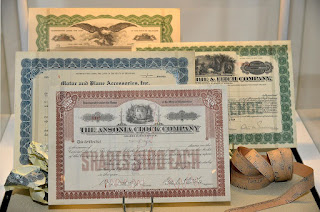The Brussels Stock Exchange was created by a decree of Napoleon in
1801. More, in 1807 he legalized the existence of limited companies.
 |
| Brussels Stock Exchange, 2006 Source : Ben2, Wikipedia |
Discover the world of the stock exchange
In Behind the Numbers, you can discover the secrets and the functioning of the stock exchange in the historical Bruxelles stock exchange building itself. On display are remarkable objects lent by a dozen of Belgian and foreign institutions, including a handful of authentic US stock certificates, a number of 19th century Belgian bond and share certificates (facsimiles) and one facsimile of the oldest stock from the Westfries Archives in Holland (see also here).
Learn and experience about the numbers
The exhibition, an initiative by TREETOP ASSET MANAGEMENT, consists of three parts:
- What is the stock exchange ? provides non-specialists with the prerequisite keys for reading, in order to help follow the rest of the exhibit.
- A history of stock exchanges shows the evolution of the stock exchange in parallel with economic development, in Europe first, later worldwide.
- How does the stock exchange work ? shows how the stock exchange forms as part of the economy, and how it benefits those who use it.
Christophe Gaeta, the scenographer of the Antwerp Red Star Line Museum, did the scenography for this exhibition as well. Gaeta created three immense cylinders, encircled by ticker tape, to evoke the constant whirlwind of stock market information. Inside the cylinders, visitors will be able to discover surprising interactive and entertaining installations (video mapping). Furthermore, the artist Charles Sandison reveals his artistic view on the stock exchange in a special piece of art 'The Mirror Room'.
Practical info
- Place: Brussels Stock Exchange building, Place de la Bourse, Brussels
- Duration : 4 September - 8 November 2015
- Opening hours: Tuesday to Sunday, 10 am to 6 pm. Last admission at 5 pm.
- Ticket price: € 8, free entrance for young people (0 to 18 years), students and schoolgroups
- More info, see here (English), here (French) or here (Dutch)
F.L.
Tip : interested in antique stocks and bonds ?
On 1 November the Boone's international bourse of antique stocks and bonds takes place at the Bruxelles NH Carrefour de l'Europe Hotel, by foot less than 10 minutes away from the exhibition. See more there.
On 1 November the Boone's international bourse of antique stocks and bonds takes place at the Bruxelles NH Carrefour de l'Europe Hotel, by foot less than 10 minutes away from the exhibition. See more there.

No comments:
Post a Comment